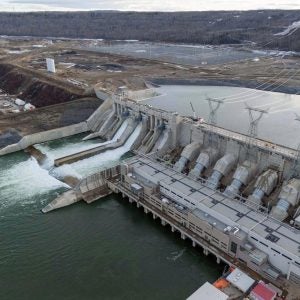The Sichuan earthquake had a magnitude of 7.9 and, because of its shallow focal depth of about 10km, the ground shaking in the epicentral region was very severe. It was also reported that the duration of earthquake was well over one minute in Chengdu.
The following assessment is based on information obtained from dam and earthquake engineers in China and other countries, and the review of reports published by the media. The author had visited the epicentral region in Dujiangyan in January 2007 where the central parts of an over 2000 year old still operational irrigation scheme are located.
Sichuan province is the province with the largest hydro power potential in China. Numerous large dam projects are either under construction or in the planning phase along the Yangtze river and its tributaries, such as the 240m high Ertan arch dam on the Yalong River.
Shortly after the devastating earthquake reports appeared of cracks on the concrete face of the 156m high Zipingpu concrete face rockfill dam (CFRD), which is located upstream of Dujiangyan City. The dam was completed in 2006 and the design reservoir volume is 1.1Bm3. At the time of the earthquake the reservoir volume was 0.32Bm3. This low level meant it was possible to detect these cracks – they would not have been visible if the reservoir were full. As modern CFRDs such as Zipingpu dam are designed to withstand severe leakages in the concrete face, and in view of the low water level in the reservoir, the dam can be considered stable and safe, as was reported by Chinese dam experts who inspected the dam after the earthquake. However, it is assumed that the amount of leakage has increased substantially at the dam after the earthquake.
According to Chinese dam design regulations, all CFRDs must be equipped with a bottom outlet, which allows the lowering of the reservoir in the case of a severe earthquake or other critical incidents. Releasing a volume of 0.32Bm3 of water from reservoirs in the Alps can usually take a couple of weeks. As considerable damage was observed it will be necessary to perform a thorough inspection of the dam before the start of the next rainy season. In view of the numerous aftershocks and the observed damage it will be necessary to closely monitor the behaviour of the dam. As Zipingpu is the first large and modern CFRD subjected to severe ground shaking, the engineers involved in the design and construction of CFRDs will be interested in getting a full picture on the earthquake behaviour of this type of dam.
According to varying sources, around 400 dams were affected by the Sichuan earthquake. Most of themse are small embankment dams, and gaining access to these sites is difficult as roads were blocked in the earthquake. Safety inspections of the affected dams are underway; however, the results have not yet been released.
Up to now, reports in the news have focused on a few spectacular cases. As in most parts of the world, many of the damaged older dams may not have been designed for earthquake action or, if they were designed for earthquakes, then most likely outdated design criteria and methods of dynamic analysis were used. The safety of the damaged and/or seismically deficient dams is a concern and it is expected that quite a few will need repair and strengthening. This was also the case after the 26 January 2001 Bhuj earthquake (Mw 7.6) in Gujarat province in India, where some 240 dams – mainly small embankment dams for water supply and irrigation – had to be strengthened. At that time no dam failure with a catastrophic flood occurred as at the time of the earthquake the water levels in the reservoirs were very low.
As most of the dams are located in mountainous regions, where many mass movements occurred, access to the damaged dams may be difficult. Therefore, further news on damaged dams and their safety are likely to appear.
Due to the large number of landslides it is expected that some smaller rivers wil be blocked. The sudden failure of such ‘earthquake’ dams may have similar consequences as the failure of one of the damaged dams.
Dr. Martin Wieland
Chairman, icold Committee on Seismic Aspects of Dam Design
Poyry Energy Ltd.
Hardturmstrasse 161
CH-8037 Zurich/Switzerland
www.poyry.com






